Orchid Vanda (lat. Vanda) is a striking representative of the Orchid family, capturing the eyes of others. But despite the exotic beauty of the epiphytic plant, you should not be fooled into it, thinking that orchids are enough for weekly watering and the windowsill is lighter. Caring for a crop is much more complicated and has its own nuances.
Material Content:
Orchid Wanda: Description
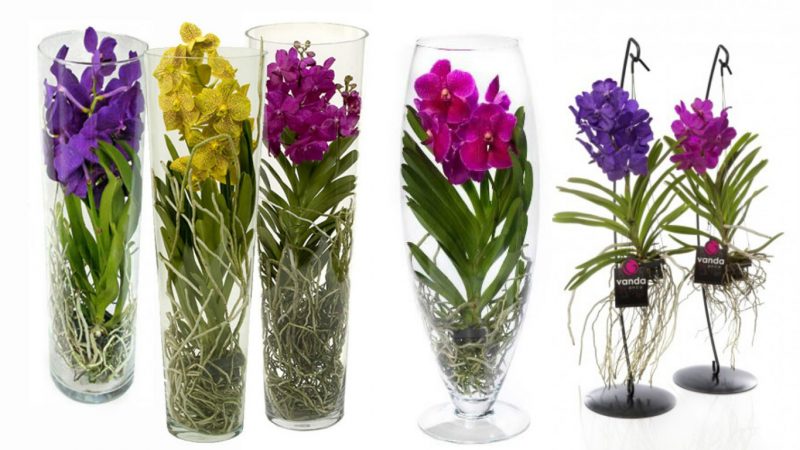
A tropical plant has a powerful root, the coating of which in the form of a thick layer of dead, porous cells allows it to receive moisture even from the atmosphere and protects the root system from burns. The long stalk is covered with regular, green leafy plates, from the sinuses of which peduncles develop. When flowering, which is observed twice a year with proper care, flowers bloom, collected from 2 to 15 pieces in racemose inflorescences. A distinctive feature of the multi-colored flowers of Wanda is the increase in their diameter with each new day of flowering. The most popular varieties and hybrids are the Vanda Blue Orchid, the Tricolor Vanda, the Wanda Rothschild and the Wanda Walnut.
Features of growing plants
Growing a Vanda orchid at home has its own characteristics that should be considered before acquiring an exotic flower:
- An evergreen does not have a pronounced stage of stagnation.
- Due to the long and tangled root system, Wanda needs a separate space, not constrained by other orchids, where she will feel comfortable.
- An exotic plant has a capricious character and requires some care, without knowing the nuances of which the grower will not be able to grow a flower.
Wanda Orchid Care at Home

It’s not at all easy to provide appropriate conditions for keeping Wanda in proper care, Moreover, caring for this variety of orchids in comparison with other representatives of the family has its own differences.
What soil is suitable for orchids?

This epiphytic plant does not need any substrate, since it can be contained on a wall or in a vase. In the case when this method of growing is too unusual for a gardener, you can place an orchid in a wide, low capacity of any color with wide drainage holes through which a support will be threaded to give the epiphyte stability. Under such conditions of maintenance, which will provide the necessary level of aeration to the roots, the tank is filled with a substrate of coarse pine bark and sphagnum in a ratio of 2: 1.
It is interesting:indoor fern: home care
Lighting and location
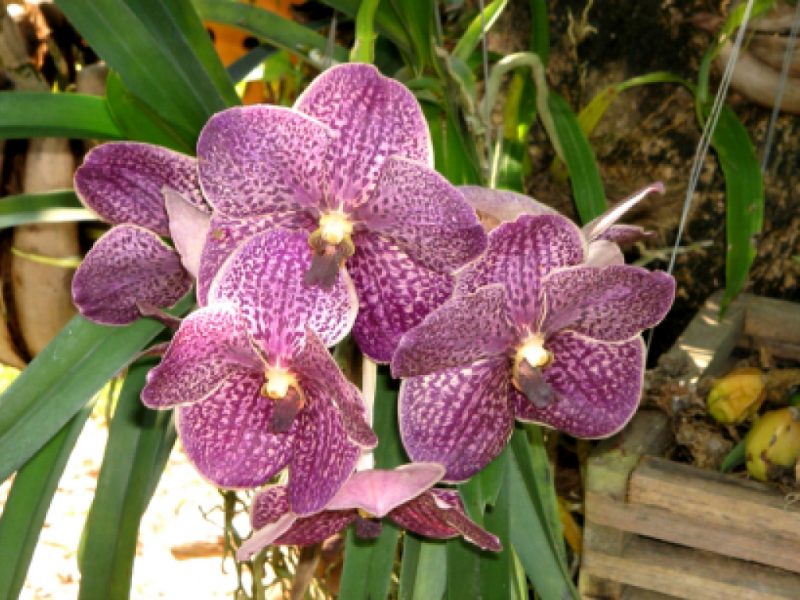
The photophilous plant should be placed on the southern window sills, where it is possible to provide the flower with a daylight duration of 12 hours - during the summer season. However, we must not forget about the intolerance of orchids in direct sunlight at noon. Using curtains, it is necessary to limit the access of the open sun. When the flower is located near the windows of other directions, it is worth organizing additional illumination using fluorescent lamps.
Temperature
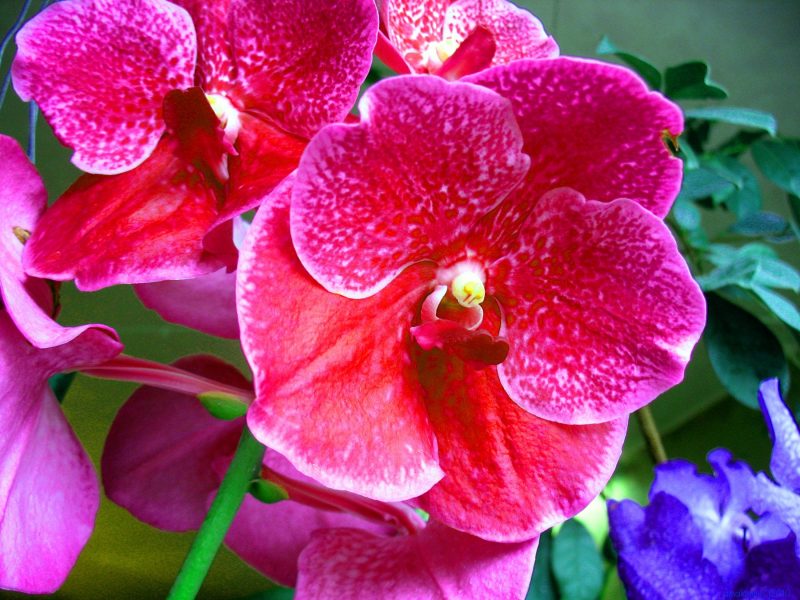
The optimal temperature regime for the Vanda orchid should be at 25 ° C, regardless of the time of year. Lowering the mercury column of the thermometer below 20 ° C causes a decrease in the immunity of the flower in front of pathogens of various diseases. Important! If in the summer heat the temperature rises above the optimum value, then such a temperature change will not harm.
Humidity
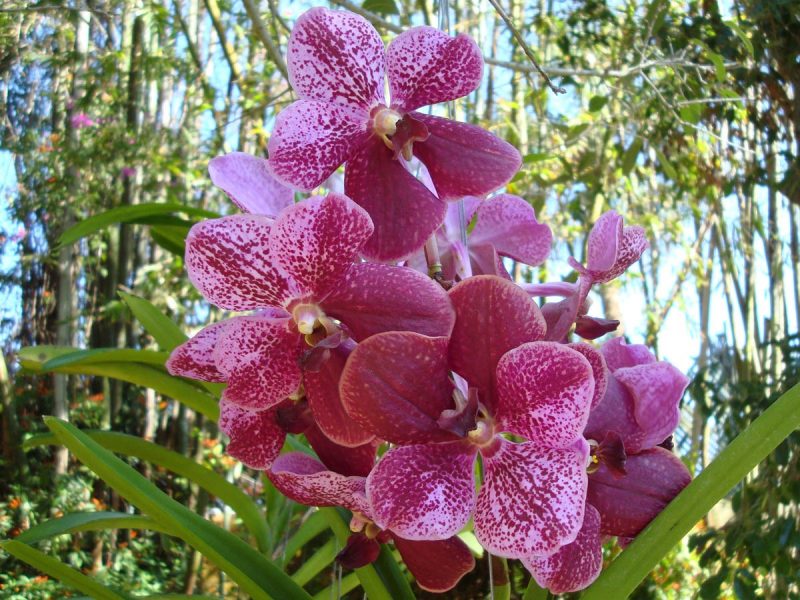
The inhabitant of the tropics needs a very high level of humidity, which is difficult to provide in an apartment environment in combination with high temperatures. To achieve the required indicator of 80-90%, spraying of leaf plates in the morning should be organized, because in the evening the flower breathes. Also, growing a plant without a substrate helps with the task — on the wall or in baskets of various materials.
Attention! The temperature of the spray water should be 3-4 ° C higher than the similar parameter of air in the containment room.
Watering a flower
An orchid is watered in the morning with warm water, which is several degrees higher than the air temperature. In the spring-summer period, a representative of the tropics organizes a 20-minute bath every day, when taken, the roots are saturated with moisture and turn green, warning that the procedure should be completed. With the advent of autumn and winter, moistening is carried out only on sunny days or in the absence of sun with an interval of 2 days.
Fertilizer and fertilizer
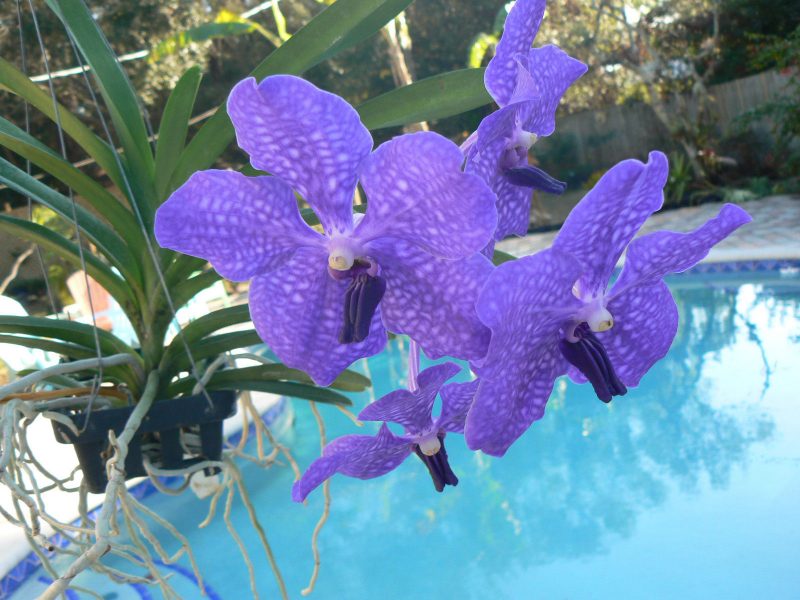
Since the epiphyte is characterized by a good appetite, Wanda needs a weekly foliar top dressing using complex mineral fertilizers for orchids. The saturation indicator will be the junction of the old and the new sheet: a strip of 1 cm will indicate a sufficient amount of nutrients.
Rules for care after flowering
After flowering is necessary:
- cut flower stalks;
- to keep the roots in a drier state - to have a warm bath once a week;
- stop spraying;
- if possible, place the orchid in the fresh air.
Transfer
If the flower grows without a substrate, then it does not need a transplant.
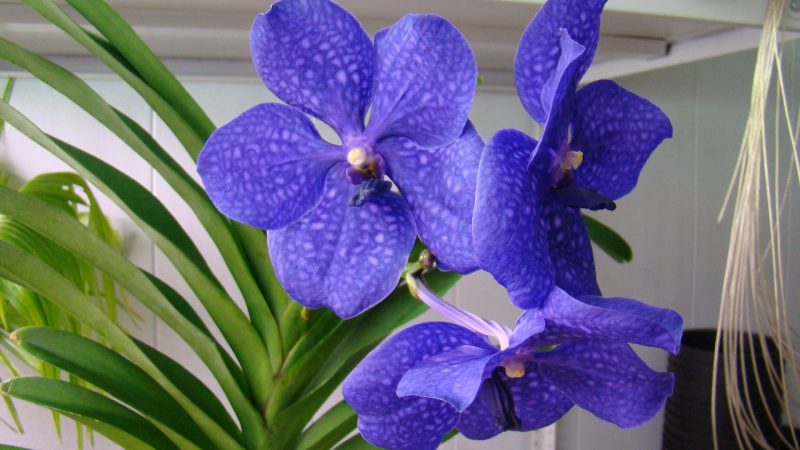
In cases where the grower decided to grow the plant on the basis of the Phalaenopsis principle, the procedure is as follows:
- The substrate is watered so that it is easier to lag behind the roots, which due to firmness and elasticity can not be afraid to damage.
- The orchid moves to a new container, where it is installed using sticks threaded through drainage holes.
- The plant is covered with a new substrate made from pine bark and moss.
How to care in autumn, winter?

Since the culture does not have a pronounced period of rest, with the advent of autumn and in the winter months, with a short daylight, the representative of the exotic flora needs to be artificially extended with the help of phytolamps. Watering in the dark is reduced and carried out every 2 days. And the indicators of humidity and temperature are maintained at the same level.
Pests, orchid diseases and protection against them
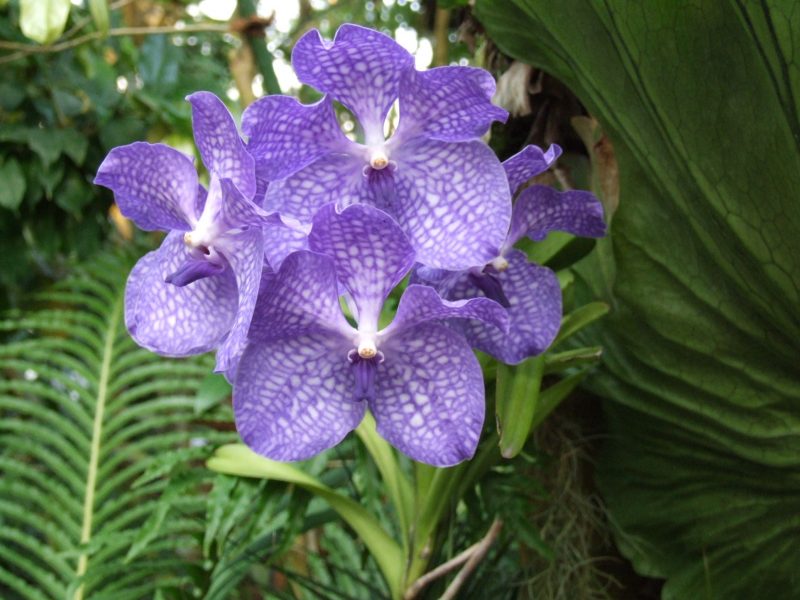
Orchid Wanda, like other indoor flowers, due to violations of the rules on the content are exposed to the settlement and development of harmful organisms, among which may be noted:
- Of the diseases - fusarium and bacterial rot, which should be combated by treatment with a solution of fungicide or a substitute biological product, which depresses the plant less.
- Of the pests - spider mites, thrips, aphids, scale insects and mealybugs, which are used to combat effective and least toxic insecticides.
Propagation of Wanda Orchid at Home
At home, the flower propagates by lateral layers - children. The procedure is carried out after the roots reach the layering, which are extremely rare, 5 cm long.
Wherein:
- The baby is separated from the maternal specimen with a sharp, sterile knife.
- Slicing sites are treated with antiseptics in the form of fungicide or crushed charcoal.
- The compact tank is filled with a substrate of pine bark and peat in a ratio of 3: 1, where the baby is placed.
- A mini-greenhouse is being built above the tank, allowing you to create the necessary microclimate, including high humidity.
- After the plant reaches a height of 20 cm, the orchid is transplanted into a large container or placed in any other suitable way.
Important! It is impossible to carry out other methods of reproduction of Wanda at home.
Do I need to transplant a flower after purchase?
The flower that has just been brought into the house is first placed in quarantine (isolation from other plants) for 15-20 days, during which the plant will be able to acclimatize under new conditions.
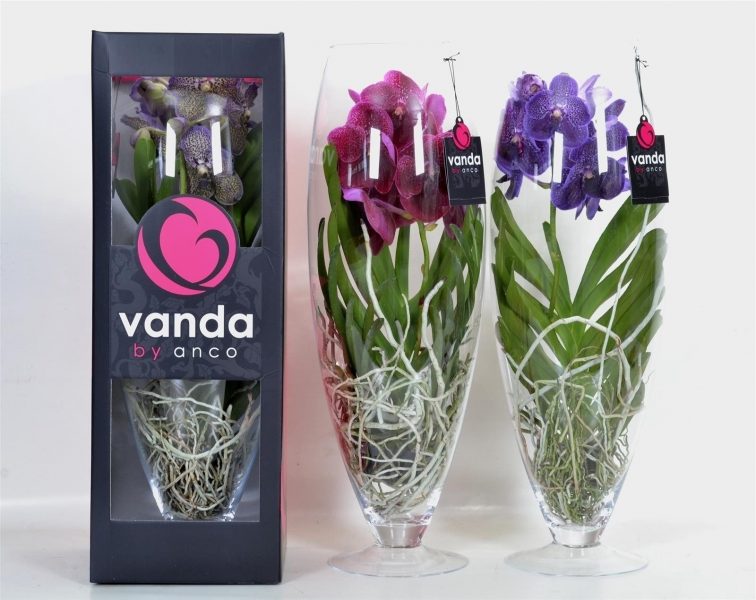
Transplantation during this period is carried out only in extreme cases when:
- Orchid Wanda, which develops beautifully without a substrate, is contained in an unsuitable soil mixture.
- Most of the roots of the flower are affected by rot.
So, the Wanda orchid, which stands out with its enchanting beauty among other orchid representatives, is quite demanding on the conditions of detention, however, the capriciousness of its nature is incomparable with the aesthetic pleasure that a flower can give to a flower grower if he provides all the necessary growing conditions.












